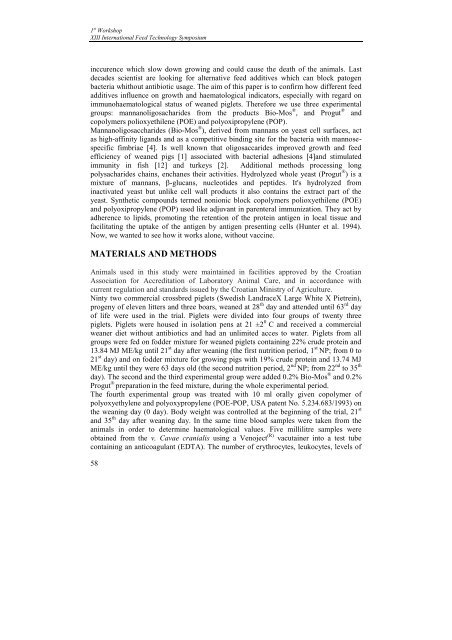Effects of dietary n-3 polyunsaturated fatty acids and ... - FINS
Effects of dietary n-3 polyunsaturated fatty acids and ... - FINS
Effects of dietary n-3 polyunsaturated fatty acids and ... - FINS
You also want an ePaper? Increase the reach of your titles
YUMPU automatically turns print PDFs into web optimized ePapers that Google loves.
1 st WorkshopXIII International Feed Technology Symposiuminccurence which slow down growing <strong>and</strong> could cause the death <strong>of</strong> the animals. Lastdecades scientist are looking for alternative feed additives which can block patogenbacteria whithout antibiotic usage. The aim <strong>of</strong> this paper is to confirm how different feedadditives influence on growth <strong>and</strong> haematological indicators, especially with regard onimmunohaematological status <strong>of</strong> weaned piglets. Therefore we use three experimentalgroups: mannanoligosacharides from the products Bio-Mos ® , <strong>and</strong> Progut ® <strong>and</strong>copolymers polioxyethilene (POE) <strong>and</strong> polyoxipropylene (POP).Mannanoligosaccharides (Bio-Mos ® ), derived from mannans on yeast cell surfaces, actas high-affinity lig<strong>and</strong>s <strong>and</strong> as a competitive binding site for the bacteria with mannosespecificfimbriae [4]. Is well known that oligosaccarides improved growth <strong>and</strong> feedefficiency <strong>of</strong> weaned pigs [1] associated with bacterial adhesions [4]<strong>and</strong> stimulatedimmunity in fish [12] <strong>and</strong> turkeys [2]. Additional methods processing longpolysacharides chains, enchanes their activities. Hydrolyzed whole yeast (Progut ® ) is amixture <strong>of</strong> mannans, β-glucans, nucleotides <strong>and</strong> peptides. It's hydrolyzed frominactivated yeast but unlike cell wall products it also contains the extract part <strong>of</strong> theyeast. Synthetic compounds termed nonionic block copolymers polioxyethilene (POE)<strong>and</strong> polyoxipropylene (POP) used like adjuvant in parenteral immunization. They act byadherence to lipids, promoting the retention <strong>of</strong> the protein antigen in local tissue <strong>and</strong>facilitating the uptake <strong>of</strong> the antigen by antigen presenting cells (Hunter et al. 1994).Now, we wanted to see how it works alone, without vaccine.MATERIALS AND METHODSAnimals used in this study were maintained in facilities approved by the CroatianAssociation for Accreditation <strong>of</strong> Laboratory Animal Care, <strong>and</strong> in accordance withcurrent regulation <strong>and</strong> st<strong>and</strong>ards issued by the Croatian Ministry <strong>of</strong> Agriculture.Ninty two commercial crossbred piglets (Swedish L<strong>and</strong>raceX Large White X Pietrein),progeny <strong>of</strong> eleven litters <strong>and</strong> three boars, weaned at 28 th day <strong>and</strong> attended until 63 rd day<strong>of</strong> life were used in the trial. Piglets were divided into four groups <strong>of</strong> twenty threepiglets. Piglets were housed in isolation pens at 21 ±2 0 C <strong>and</strong> received a commercialweaner diet without antibiotics <strong>and</strong> had an unlimited acces to water. Piglets from allgroups were fed on fodder mixture for weaned piglets containing 22% crude protein <strong>and</strong>13.84 MJ ME/kg until 21 st day after weaning (the first nutrition period, 1 st NP; from 0 to21 st day) <strong>and</strong> on fodder mixture for growing pigs with 19% crude protein <strong>and</strong> 13.74 MJME/kg until they were 63 days old (the second nutrition period, 2 nd NP; from 22 nd to 35 thday). The second <strong>and</strong> the third experimental group were added 0.2% Bio-Mos ® <strong>and</strong> 0.2%Progut ® preparation in the feed mixture, during the whole experimental period.The fourth experimental group was treated with 10 ml orally given copolymer <strong>of</strong>polyoxyethylene <strong>and</strong> polyoxypropylene (POE-POP, USA patent No. 5.234.683/1993) onthe weaning day (0 day). Body weight was controlled at the beginning <strong>of</strong> the trial, 21 st<strong>and</strong> 35 th day after weaning day. In the same time blood samples were taken from theanimals in order to determine haematological values. Five millilitre samples wereobtained from the v. Cavae cranialis using a Venoject (R) vacutainer into a test tubecontaining an anticoagulant (EDTA). The number <strong>of</strong> erythrocytes, leukocytes, levels <strong>of</strong>58
















